Brazil is the fifth largest nation in the world, sprawling across 3.2 million square miles of South American soil. Having gained its independence from Portugal in 1825, Brazil stakes claim as the only Portuguesespeaking country in Latin America, and is ranked by Immigration World as one of the top 10 migration-friendly destinations on the planet. As a result of the influx of immigrants, the Brazilian dinner table is a melting pot of international influence, including European, African and Oriental fusions as well as native Indian and traditional Brasileiro flavors.
As is typical in the United States, what might be considered a perfect food choice in Brazil depends on which area you are dining in. Shelida Cazé, a 35-year-old native of the southeastern state of Espírito Santo, has traveled extensively throughout the country and is familiar with the smorgasbord of local preferences.
Southern Brazil
“In the extreme southeastern regions like Rio Grande do Sul or Santa Catarina where the weather is cooler, there is a large population of Italian and German immigrants,” she says. “The main course at a festa grande in this area might end up being pasta and meat sauce or lasagna, dishes not typically associated with traditional Brazilian cuisine.”
The Amazon Region
“The cuisine in the state of Amazonas is one of the most exotic in the whole of Brazil,” Cazé explains. “The state maintains one of the most indigenous cultures in the country, with little Portuguese or African influence in its gastronomy. It is bathed by the watershed of the Amazon River and fish are widely used in their dishes. Exotic fruits are also common in the region, such as tucumã, which is present in several recipes.” Shelida says there are a plethora of Amazonian fruits, including the açaí, graviola and guaraná da Amazônia that are exported from the region to other parts of the country.
“Fish — baked, boiled or served fried are part of the typical dishes in the north,” she says. “Tucupi (sauce made from braised cassava, a woody shrub similar to yucca) and gum (tapioca flour) are used to break the acidity of the food. Leaves of Jambu provide a touch of anesthesia in the mouth. To complete the recipe, you need salty prawns crustaceans similar to shrimp.”
Espírito Santo
On the small island of Guriri, situated halfway up the coast of Espírito Santo (where Cazé currently lives), the day begins at 6 a.m. with the tantalizing aromas of fresh Brazilian coffee and pastels mingling with the ocean breeze. Street markets teem with fruits and vegetables and vendors peddle agua de coco (coconut water) on street corners and sidewalks. Padarias, which combine traditional bakeries with 1950s style snack counters, sell fresh bread, meat-filled pastries and regionally-roasted coffee. A cup of robust café Brasileiro and a few hunks of pão de queijo (bread baked with cheese) will cost you about the equivalent of $2.33 U.S. dollars.
A Brazilian Twist
A diner in Espírito Santo might find menu choices that resemble traditional American cuisine – but with a decidedly Brazilian twist. A pizza, for example, is similar to an American take-out in terms of the dough and tomato sauce base, but the toppings may include ham, onions, whole green olives, tomato slices, corn, peas and miniature hard-boiled eggs, called ovos de codorna. Visitors are hard pressed to find a hamburger sans fried eggs and potatoes on top, and don’t even think about ordering french fries without reaching for a toothpick (for handling) and asking for both ketchup and mayonnaise.
More typical of the region is traditional churrosco meat (seasoned bits of steak cooked over open flame and served on a skewer) with a side of rice and beans.
Moqueca Capixaba
“Espírito Santo is one of the smallest states in Brazil,” Cazé says, “but its small territory is inversely proportional to its culture and cuisine. The greatest part of Espírito Santo is bordered by the Atlantic Ocean, and the mixture of cultures are reflected in its gastronomy. Indian, Portuguese, European, Italian and African influences produce a special cultural mix and, allied with the fishing tradition, generate dishes that are only found here.”
Exotic-sounding courses like torta, muma de siri, caranguejada and peixe frito peroá are all touted as specialties in Espírito Santo. Cazé says if she had to pick the perfect Brazilian food for those who live in southeastern Virginia to enjoy, it would be moqueca capixaba, a hearty porridge filled with vegetables and fish.
“Moqueca capixaba is cooked in a traditional tempered clay pot called a panela de barro,” Cazé says. “This is what constitutes the main cultural element. The stew consists of tomatoes, garlic, onion, coriander and annatto dye, accompanied by white rice and mashed manioc flour.”
In Espírito Santo, October ushers in the spring season, bringing longer days and slightly warmer weather. Cooler weather is on the doorstep 4,000 miles north in Virginia. A steaming crockpot of moqueca capixaba might be the perfect culinary companion for watching football, catching up on a novel or enjoying an evening with friends. Pull out the crockpot, add some samba to your playlist and enjoy.
Moqueca Capixaba pronounced mokeka capishaba
INGREDIENTS
- 2 1/4 pounds sea bass, cubed
- 1 lime, halved
- 1 bunch green onions, diced
- 1 bunch cilantro, diced
- 2 medium onions, sliced
- 3 garlic cloves, crushed
- 4 large tomatoes, diced
- 2 tbsp. olive oil
- 2 tbsp. annatto dye
- 1/2 cup water
- 1 small bottle coconut milk
- 4 tbsp. cassava flour
- Salt and pepper to taste
INSTRUCTIONS
In a bowl, add the cubes of sea bass with juice of one lemon and salt to taste. Heat a large pan on medium heat and mix the olive oil and cloves of crushed garlic. Let cook until golden. Next, add the annatto dye, onion, cilantro, green onions and diced tomatoes to the pan; add the seasoned sea bass last.
Let cook on medium to medium-high for 20 minutes. In another pan for the flour mortar, place two ladles of the fish/vegetable broth and half a small bottle or can of coconut milk. Add cassava flour and water. Stir over medium heat for 10 minutes or until the flour is dissolved. Return the broth to the pan with the vegetables and fish, and let simmer until desired consistency is attained.
Serve warm accompanied by white rice.


